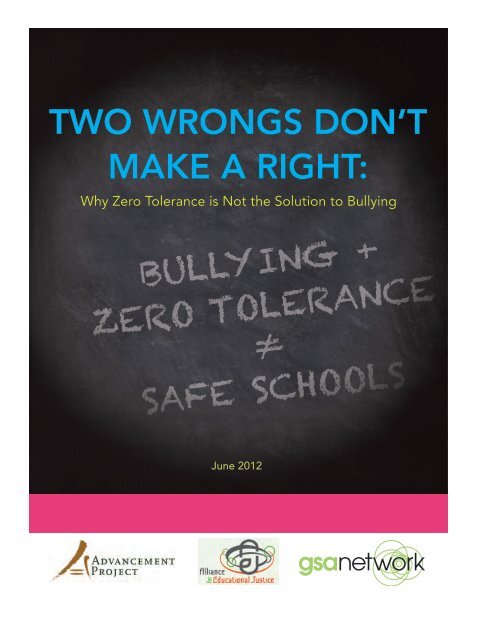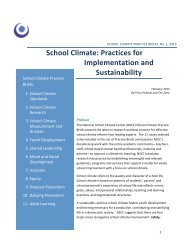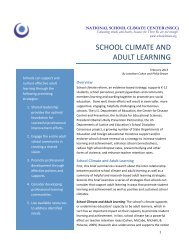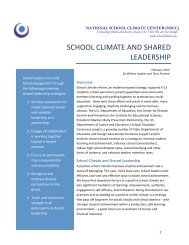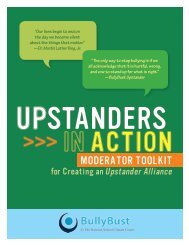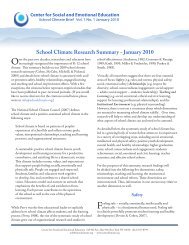two wrongs don't make a right - National School Climate Center
two wrongs don't make a right - National School Climate Center
two wrongs don't make a right - National School Climate Center
Create successful ePaper yourself
Turn your PDF publications into a flip-book with our unique Google optimized e-Paper software.
TWO WRONGS DON’T<br />
MAKE A RIGHT:<br />
Why Zero Tolerance is Not the Solution to Bullying<br />
June 2012
Advancement Project is a next generation, multi-racial civil <strong>right</strong>s organization. We tackle inequity with<br />
innovative strategies and strong community alliances. With a national office in Washington, DC and <strong>two</strong><br />
offices in California, we combine law, communications, policy and technology to create workable solutions<br />
and achieve systemic change. We aim to inspire and strengthen movements that expand opportunity for all.<br />
See www.advancementproject.org for more information.<br />
The Alliance for Educational Justice (AEJ) is a national alliance of youth organizing and intergenerational<br />
groups working for educational justice. AEJ aims to bring grassroots groups together to bring about changes<br />
in federal education policy, build a national infrastructure for the education justice sector, and build the<br />
capacity of our organizations and our youth leaders to sustain and grow the progressive movement over<br />
the long haul. AEJ’s current campaigns focus on ending the school to prison pipeline by increasing funding<br />
for community and youth led solutions to improving school culture, an end to school closings in low income<br />
communities of color, and we are building a movement towards the creation of a <strong>National</strong> Student Bill of<br />
Rights. See www.allianceforeducationaljustice.org for more information.<br />
Gay-Straight Alliance Ne<strong>two</strong>rk (GSA Ne<strong>two</strong>rk) is a national youth leadership organization that empowers<br />
youth activists to fight homophobia and transphobia in schools by training student leaders and supporting<br />
student-led Gay-Straight Alliance clubs throughout the country. In California alone, GSA Ne<strong>two</strong>rk has brought<br />
GSA clubs to 56% of public high schools, impacting more than 1.1 million students at 880 schools. GSA<br />
Ne<strong>two</strong>rk’s youth advocates have played a key role in changing laws and policies that impact youth at the local<br />
and state level. GSA Ne<strong>two</strong>rk operates the <strong>National</strong> Association of GSA Ne<strong>two</strong>rks, which unites 37 statewide<br />
ne<strong>two</strong>rks of GSA clubs throughout the country. GSA Ne<strong>two</strong>rk is also the founder of the Make It Better Project,<br />
which aims to stop bullying and prevent suicide. See www.gsane<strong>two</strong>rk.org for more information.<br />
2 TWO WRONGS DON’T MAKE A RIGHT
INTRODUCTION<br />
What responsibility do policy<strong>make</strong>rs have to respond to the bullying and harassment of students in school?<br />
How can schools better meet the needs of lesbian, gay, bisexual, transgender, and questioning (LGBTQ) students?<br />
How can we ensure that schools are safe spaces for all students?<br />
Fortunately, following a long, ignoble history of systemic failures to address the bullying and harassment of students,<br />
particularly LGBTQ students, these questions are now being considered far more than ever before. It seems that<br />
many law<strong>make</strong>rs have been sensitized to the harms caused by bullying, harassment, and hostile school climates, and<br />
have responded with an unprecedented surge in policy and legislative activity. While the need to address this deeply<br />
harmful school behavior is undoubtedly urgent, the unfortunate trend has been to respond to bullying and harassment<br />
by referring so-called “bullies” to the police or using other harsh, “zero-tolerance” disciplinary measures that exclude<br />
students from school.<br />
TWO WRONGS DON’T MAKE A RIGHT 1
INTRODUCTION<br />
This policy trend is remarkably similar to what happened as concerns over school safety escalated in the 1990s<br />
and early 2000s, particularly after high-profile school shootings like the one at Columbine High <strong>School</strong>. The<br />
response in many schools throughout the country was to rely more heavily on law enforcement agencies and<br />
the use of zero-tolerance measures. As has been well-documented, these policies and practices have failed to<br />
produce safer or more effective schools, 1 but have produced a variety of other harmful outcomes, including:<br />
• Unnecessary use of school-based arrests and juvenile court citations; 2<br />
• Overuse and misuse of out-of-school suspensions, expulsions, and transfers to alternative disciplinary<br />
schools/programs; 3<br />
• Excessive use of metal detectors, surveillance cameras, Tasers, and other aggressive security measures; 4<br />
and<br />
• Overly-aggressive school security and law enforcement officials. 5<br />
This dangerous cocktail of policies and practices – often called the “<strong>School</strong>-to-Prison Pipeline” – has led to huge<br />
numbers of students being “pushed out” of school and criminalized across the country. The effects have been so<br />
devastating for these students, their families, and entire communities that numerous community-led efforts to<br />
dismantle the Pipeline and end the overly-harsh discipline of students have sprung up across the country within<br />
the last several years. 6<br />
Nevertheless, the same policies are now being widely used in response to the growing national concern over<br />
bullying. While there is no question that student-on-student harassment that goes unaddressed is a grave threat<br />
to the well-being of many youth, the threat posed to students by the over-reliance on police and zero-tolerance<br />
measures is just as great. Indeed, they share many of the same outcomes. Both produce severe psychological,<br />
emotional, and academic trauma in their victims. 7 Both create hostile, alienating school environments that affect<br />
other students and staff alike. Both have dramatic systemic effects, including worsening academic achievement<br />
and decreasing graduation rates. 8 Indeed, the often-devastating impact of bullying is strikingly similar to the<br />
harm caused by the mistreatment, harassment, and even violence suffered by students as a result of the many<br />
excessively harsh school disciplinary policies and practices currently in use throughout the country.<br />
Thus, while the efforts to punish bullying harshly and even address it criminally are well-intentioned, they are<br />
nevertheless misguided (with some limited exceptions 9 ) in that they reinforce the <strong>School</strong>-to-Prison Pipeline<br />
and the excessive involvement of law enforcement in the lives of students. The zero-tolerance approach simply<br />
will not solve the grave problem of bullying and harassment of students, but it will cause substantial additional<br />
harm, including for the very students it is intended to protect. 10 All young people, both LGBTQ and non-LGBTQ,<br />
will suffer if we fail to see that the zero-tolerance approach is a form of bullying, not a solution to it. All students<br />
should feel safe, supported, and protected from violence, bullying, and mistreatment, whether it is from other<br />
students, the adults charged with educating them, or broader institutional forces.<br />
2 TWO WRONGS DON’T MAKE A RIGHT
BULLYING & THE SAFE SCHOOLS MOVEMENT<br />
Bullying is aggressive behavior that is intentional, involves an imbalance in power or strength, and is typically<br />
repeated over time. 11 It can take on many forms, such as hitting and punching (physical bullying), teasing and<br />
name-calling (verbal bullying), intimidation using gestures or social exclusion (nonverbal or emotional bullying),<br />
and online harassment (cyber-bullying). 12 Students face bullying and harassment for a wide variety of reasons,<br />
including how they look, how they choose to dress and express themselves, whether they have a disability, their<br />
size, their socioeconomic status, their ethnic heritage, their immigration status, their sexual orientation, their<br />
gender identity or expression, their religious beliefs, and even the activities they like or the type of music they<br />
listen to. Bullying affects students of every race, ethnicity, religion, sexual orientation, gender, and class. In fact,<br />
researchers estimate that in the United States, nearly 30% of students are either the victims of bullying, bully<br />
others, or both, within a given year. 13 A majority of students say they have experienced some form of school<br />
bullying during their school years. 14 Yet LGBTQ students are particularly affected by this behavior. In fact, over 8<br />
out of 10 LGBTQ youth report being verbally harassed about their sexual orientation at school, and 6 out of 10<br />
report feeling unsafe in school. 15<br />
TWO WRONGS DON’T MAKE A RIGHT 3
BULLYING & THE SAFE SCHOOLS MOVEMENT<br />
For all students, bullying can lead to:<br />
• Academic Difficulties. Bullying distracts students from the most important part of their school<br />
experience – their education. Students who face bullying and harassment are more likely to see their<br />
GPAs and other indicators of academic success drop. 16<br />
• Truancy. For victims of bullying who are not supported by their school, regularly skipping classes or<br />
entire school days out of fear can become a survival mechanism. 17<br />
• Acting Out. Frustrated with the lack of support from peers and educators, students who face harassment<br />
and bullying may act out in class or on school grounds. 18<br />
• Self-Defense. Students who are bullied and do not have access to supportive services or safe<br />
interventions often find that fighting back is their only option. Victims of bullying may turn to physically<br />
defending themselves against bullies, carrying weapons, and other survival tactics that endanger the<br />
school community. 19 As a result, all students are at greater risk of physical harm, while the victims of<br />
bullying are more vulnerable to being suspended, expelled, or even arrested.<br />
• Psychological Trauma and Mental Health Consequences. Students who face bullying and harassment are<br />
at greater risk of suffering from depression, loneliness, anxiety, low self-esteem, and suicidal thoughts. 20<br />
• Dropping Out or Being Pushed Out of <strong>School</strong>. A safe and nurturing school climate is vital to retaining<br />
students in schools. Bullied students who are deprived of that environment are at higher risk of dropping<br />
out or, in many cases, being pushed out of school by unsupportive students and adults. 21<br />
In the late 1980s, student groups known as Gay-Straight Alliance Clubs began to form in response to the<br />
profoundly negative impact that bullying has on individual students as well as overall school culture. As these<br />
student groups proliferated in high schools across the country in the mid- and late-1990s, the Safe <strong>School</strong>s<br />
Movement emerged as a school-based organizing and advocacy effort for LGBTQ student justice. Since that<br />
time, youth advocates and their allies have sought to create safe spaces for LGBTQ students and secure greater<br />
protections for bullied and harassed students, particularly through the implementation of non-discrimination<br />
and anti-harassment policies covering actual or perceived sexual orientation, gender identity, and gender<br />
expression. As a result of these inspiring efforts, other innovative advocacy projects such as the “It Gets Better” 22<br />
and “Make it Better” 23 campaigns, and the sharply increased public attention on bullying nationally, policy<strong>make</strong>rs<br />
have begun taking notice, and taking action, in far greater numbers.<br />
For example, the Obama administration has hosted <strong>two</strong> national conferences on bullying and launched www.<br />
stopbullying.gov. 24 The U.S. Department of Education provided guidance to school districts reminding them that<br />
failure to effectively deal with bullying in their schools could be considered a violation of civil <strong>right</strong>s law. 25<br />
There are also multiple pieces of legislation pending in Congress, 26 and state law<strong>make</strong>rs are addressing the<br />
issue with unusual swiftness. In fact, 21 states passed new legislation or updated existing legislation to address<br />
bullying in 2010 (compared to one in the year 2000). 27 23 states signed anti-bullying bills into law in 2011, and an<br />
additional four have already addressed the issue in 2012. 28<br />
4 TWO WRONGS DON’T MAKE A RIGHT
Number of States Passing Bullying Laws:<br />
2000 Compared with 2011-2012 (as of 6/1/12)<br />
30<br />
25<br />
20<br />
15<br />
10<br />
5<br />
0<br />
1<br />
27<br />
2000 2011-2012<br />
However, as will be discussed<br />
below, while the intentions behind<br />
all of these initiatives have been<br />
admirable, the same cannot<br />
be said for all of their content.<br />
Indeed, the rapid response of many<br />
policy<strong>make</strong>rs has unfortunately<br />
produced too many policy changes<br />
that fail to address the deeper issues<br />
around bullying and are likely to<br />
create more problems than they<br />
solve. 29<br />
Sources: U.S. Department of Education; Advancement Project<br />
ZERO TOLERANCE & THE MOVEMENT TO<br />
END THE SCHOOL-TO-PRISON PIPELINE<br />
As an outgrowth of the War on Drugs and other “tough-on-crime” strategies that have produced an<br />
extraordinary increase in the number of incarcerated Americans over the last 25 years, 30 there has been a<br />
dramatic shift in school discipline policies and practices in recent years. 31 Within many communities, educators<br />
have deemphasized traditional school-based disciplinary interventions while greatly expanding their use of zerotolerance<br />
disciplinary approaches that exclude students from their schools through out-of-school suspensions,<br />
expulsions, and referrals to alternative schools or programs. 32 At the same time, many schools have become<br />
over-reliant on police and juvenile courts to handle school disruptions that should be handled within school<br />
settings. And while the original intent of these policies and practices was to address serious threats to school<br />
safety – such as the rare student who carries a dangerous weapon or sells drugs within a school – the reality is<br />
that the vast majority of these extreme punishments are imposed for behaviors that do not pose a serious threat<br />
to school safety, such as classroom disruptions, skipping school, minor fights, and dress code violations.<br />
Not only have the consequences for student behavior become more severe, the atmosphere within many<br />
schools has been poisoned by the overuse of these “get-tough” measures as well. Metal detectors and<br />
surveillance cameras have proliferated, while school police and security forces regularly employ aggressive<br />
enforcement tactics on students. 33 In fact, the intimidation, harassment, brutality, and other misconduct of some<br />
school police and security officers have turned many schools into hostile environments for the students they are<br />
supposed to be serving. 34<br />
These misguided disciplinary approaches have created a <strong>School</strong>-to-Prison Pipeline, endangering educational<br />
opportunities and making dropout and incarceration far more likely for millions of children and youth across<br />
TWO WRONGS DON’T MAKE A RIGHT 5
ZERO-TOLERANCE & THE MOVEMENT TO END THE SCHOOL-TO-PRISON PIPELINE<br />
the country. Students as young as five-years-old, of all races, ethnicities, and socioeconomic statuses have been<br />
thrust into the Pipeline by disciplinary methods that prioritize senseless and unjust consequences, student<br />
exclusion, and justice-system intervention over students’ <strong>right</strong> to an education. Nevertheless, it continues to fall<br />
hardest on students of color, students with disabilities, and LGBTQ youth. 35<br />
The effects of these overly-aggressive policies and practices are remarkably similar to the effects of student-onstudent<br />
bullying, including:<br />
• Academic Difficulties. Students who are not in class are, of course, not doing much learning. Thus,<br />
students subjected to harsh disciplinary measures that exclude them from school tend to fall behind<br />
academically. 36<br />
• Truancy. Students who face harsh discipline often feel alienated from their schools, resulting in more<br />
absenteeism. 37<br />
• Acting Out. Students punished by zero-tolerance measures often fall behind their peers due to lost<br />
learning time. As a result, they often become frustrated or embarrassed that they are not at their peers’<br />
level, and proceed to disrupt class. 38<br />
• Self-Defense. Students who feel oppressed by toxic school climates often respond with verbal outbursts,<br />
defiance of authority, violence, or simply skipping school. 39 These defense mechanisms are also<br />
frequently punished with additional zero-tolerance measures, creating a destructive downward spiral.<br />
• Psychological Trauma and Mental Health Consequences. The almost prison-like conditions endured<br />
by many students can have deep psychological effects. 40 Additionally, unjust disciplinary consequences<br />
are frequently traumatizing for young people, leading to public humiliation, diminished self-worth,<br />
and distrust of school officials. 41 They also often trigger a cycle of disengagement from schools, where<br />
students become less trusting and more resentful of their teachers, losing the “connectedness” that is<br />
such a critical component of academic success. 42 As youth become more alienated, they also become<br />
more likely to engage in risky behaviors, violence, and alcohol and substance abuse. 43<br />
• Dropping Out or Being Pushed Out of <strong>School</strong>. Zero-tolerance discipline sends a clear message to<br />
students that they are not valued; unfortunately, that message has gotten through to far too many<br />
students who have been pushed out of school by unnecessarily severe disciplinary measures. 44<br />
To <strong>make</strong> matters worse, the zero-tolerance approach has failed to even achieve its stated purpose: to <strong>make</strong><br />
schools safer and more effective. 45 Instead, zero-tolerance practices have harmed school improvement efforts<br />
while also wasting valuable resources. 46<br />
The <strong>School</strong>-to-Prison Pipeline has wreaked havoc in communities across the country, leading to a groundswell<br />
of grassroots advocacy to implement school disciplinary practices that are proven to promote academic success,<br />
improve school safety, and save taxpayer resources. In response to the chorus of voices calling for change, many<br />
school districts and state legislatures have begun to take action to address student pushout and unhealthy<br />
6 TWO WRONGS DON’T MAKE A RIGHT
learning environments. 47 At the federal level, the Departments of Education and Justice have embarked on a<br />
joint Supportive <strong>School</strong> Discipline Initiative, 48 and Congress has begun to devote more attention to disciplinary<br />
concerns. 49<br />
This recent activity does provide hope that policy<strong>make</strong>rs will begin treating education as a <strong>right</strong> for all young<br />
people, not as a privilege that can be easily taken away by zero-tolerance measures. But in the meantime, these<br />
ineffective and counter-productive disciplinary measures continue putting countless students on a path to<br />
incarceration.<br />
MOVEMENTS IN CONFLICT?<br />
The movements to address bullying and the <strong>School</strong>-to-Prison Pipeline have much in common: both are intended<br />
to address severe harms to youth that too often go unnoticed; both seek to lessen the alienation and pushout of<br />
students; both aim to create healthier schools and communities; and both are being led by affected youth and<br />
parents. These <strong>two</strong> grassroots movements are doing vitally important work to ensure that the health, well-being,<br />
and educational opportunities of all young people are protected. Nevertheless, these well-intentioned efforts<br />
have inadvertently come into conflict, especially within the last <strong>two</strong> years.<br />
One of the causes of the <strong>School</strong>-to-Prison Pipeline is that, within many schools, the definition and understanding<br />
of discipline has changed. Before the explosion in zero-tolerance approaches (and still today in the schools<br />
that did not adopt the get-tough philosophy), discipline was viewed as part of the role of educators in teaching<br />
behavior, and there were dozens of preventive strategies and interventions used to assist students in their<br />
learning. Interventions that excluded students from school for days, weeks, or months at a time were far more<br />
rare, and police intervention was virtually unheard of (as it still is, at some schools).<br />
Yet over the last several years—and due in significant part to the easy political appeal of harsh disciplinary<br />
approaches 50 —the techniques designed to teach better or more appropriate behavior, and address the root<br />
causes of disciplinary issues, have become far less common. There has been a severe narrowing in policy<strong>make</strong>rs’<br />
understanding of the approaches available to address disciplinary matters. Thus, when policy<strong>make</strong>rs are asked,<br />
or required, to address concerns over bullying, there has been a tendency to place far too much emphasis on<br />
the same strategies that have created the <strong>School</strong>-to-Prison Pipeline: out-of-school suspensions, expulsions,<br />
referrals to alternative disciplinary schools/programs, and even going so far as to arrest and prosecute students<br />
for behavior that would best be addressed within schools. As a result, within this flurry of policymaking over the<br />
last <strong>two</strong> years, many efforts to address bullying have collided with efforts to reform unnecessarily harsh school<br />
discipline.<br />
Indeed, there has been a striking trend toward the use of harsh punishments to address bullying and harassment.<br />
For example:<br />
• According to the U.S. Department of Education, of the 42 states with bullying laws that address the<br />
consequences of bullying, 57% of them (24 states) rely solely on punitive measures. 51<br />
TWO WRONGS DON’T MAKE A RIGHT 7
MOVEMENTS IN CONFLICT?<br />
• The other 18 states<br />
include more references<br />
to supportive or remedial<br />
interventions, but there<br />
is nevertheless a trend<br />
toward the inclusion of new<br />
punishments for bullying in<br />
these states. 52<br />
• Of the 40 states that provide<br />
their school districts with<br />
model bullying policies and<br />
guidance that address the<br />
consequences of bullying,<br />
16 of them refer only to<br />
punitive measures. 53<br />
Analysis of State Laws that Address<br />
the Consequences of Bullying (as of 4/30/11)<br />
Laws that Rely<br />
Solely on<br />
Punitive<br />
Consequences<br />
57%<br />
Source: U.S. Department of Education<br />
43%<br />
Laws that Rely<br />
on Punitive<br />
Consequences<br />
& Supportive/<br />
Remedial<br />
Interventions<br />
• Once again, many of the<br />
policies from the other 24<br />
states rely excessively on harsh disciplinary consequences. 54<br />
• In a study of school district policies by the U.S. Department of Education, 50% of the sample studied<br />
relied exclusively on punitive measures to address bullying. 55<br />
Many of the anti-bullying policies, particularly those passed in the last <strong>two</strong> years, rely on or mirror the harshest<br />
school discipline policies enacted post-Columbine (which themselves mirrored some of the harshest criminal<br />
justice policies implemented in the 1980s and 1990s). 56 But perhaps the most striking trend in these new laws<br />
and policies is the expanded role for law enforcement in addressing student behavior. 57 While historically this<br />
responsibility fell almost exclusively to schools, there is now a strong tendency toward treating bullying as<br />
criminal conduct that should be handled through the criminal justice system. 58 For example:<br />
• Fifteen states have passed bullying laws that include procedures for imposing criminal sanctions for<br />
bullying behavior. 59<br />
• Over one-half of the districts studied by the U.S. Department of Education outline procedures for<br />
reporting bullying offenses to law enforcement. 60<br />
• In many places, law enforcement has become the first resource to turn to in even the most minor<br />
incident of bullying. For example, numerous states have passed laws requiring that bullying behaviors be<br />
reported to law enforcement. 61 In New Jersey, students are encouraged to report their classmates to a<br />
Crime Stoppers hotline for alleged bullying. 62<br />
• Eight states have created new crimes, or modified existing ones, to include bullying behaviors. 63 For<br />
example, Idaho has created the crime of “harassment, intimidation, or bullying” against students. 64<br />
8 TWO WRONGS DON’T MAKE A RIGHT
The trend is clear: states and districts are becoming just as reliant on overly-harsh responses for bullying and<br />
harassment as they are for other student disciplinary matters. As a result, much of the progress realized by the<br />
<strong>School</strong>-to-Prison Pipeline movement in eliminating the over-reliance on these ineffective and counter-productive<br />
practices is either being jeopardized or actively eroded.<br />
HARSH RESPONSES TO BULLYING & THE EXPANSION<br />
OF THE SCHOOL-TO-PRISON PIPELINE<br />
This emphasis on out-of-school suspensions, expulsions, alternative placements, and the criminalization of youth<br />
to address bullying is profoundly misguided. Just as the zero-tolerance philosophy has failed to <strong>make</strong> schools<br />
safer and more effective, so too will it fail to adequately address bullying because it:<br />
• Subjects huge numbers of youth to very severe punishments;<br />
• Does not address the root causes of bullying and stop the bullying cycle by teaching appropriate<br />
behavior;<br />
• Casts such a wide behavioral net that it ends up harming those students it is supposed to protect; and<br />
• Contributes to the deterioration of learning environments and the alienation of students.<br />
Not only were the penalties for bullying increased in many of these recently-enacted laws and policies, the<br />
definition of bullying was also substantially broadened. 65 Because data shows that most youth experience<br />
bullying directly – meaning a substantial number of youth are committing acts defined as “bullying” 66 – a massive<br />
number of children and youth are at greater risk of entering the <strong>School</strong>-to-Prison Pipeline as a result of this<br />
policymaking trend. While the actions of some young people may necessitate temporary removal from school<br />
or an alternative placement, most will not. Thus, just as zero-tolerance for other disciplinary matters has led<br />
to severe punishments for vast amounts of developmentally normal behavior, so too can we expect these new<br />
bullying laws and policies to catch far too many students in their net.<br />
Additionally, there is no reason to expect that this harsh approach will achieve its desired outcomes. Zerotolerance<br />
measures are a mere stopgap that fails to teach the offending students why their behavior is<br />
inappropriate or harmful and how they can improve it. So-called “bullies” are, of course, youth themselves, and<br />
are thus struggling with their own insecurities – about their intelligence, social skills, physical attractiveness,<br />
attraction to others, gender expression, etc. – and are often just learning to understand themselves and the<br />
world around them. They are themselves frequently victims of messages of intolerance, hostility, and hate at<br />
home, at school, and from the media.<br />
Bullying interventions that rely on exclusion or justice-system intervention miss critical opportunities to respond<br />
to these acute needs, break down these harmful behavioral patterns, and help teach misguided youth the<br />
social and emotional skills they will need to stop bullying and ultimately grow up to be healthy, mature, and<br />
responsible adults. Zero-tolerance responses also squander the opportunity to create healthier, more inclusive,<br />
TWO WRONGS DON’T MAKE A RIGHT 9
HARSH RESPONSES TO BULLYING & THE EXPANSION OF THE SCHOOL-TO-PRISON PIPELINE<br />
and more productive learning environments. Instead, just as with other student disciplinary matters, harsh<br />
responses to bullying usually only <strong>make</strong> matters worse, and create new problems, by putting the “bully” on a<br />
fast track toward dropping out and winding up in jail.<br />
Indeed, zero-tolerance responses can actually have the unintended effects of strengthening a bully’s resolve and<br />
further victimizing the recipient of his or her aggression. And where harsh responses are the norm, or even a<br />
regular practice, there can be a “chilling effect” on teachers and other adults even reporting bullying because of<br />
the fear that the consequences will be more severe than is appropriate.<br />
Additionally, harsh responses to bullying can actually wind up harming the very students they are intended to<br />
protect. For example, by reinforcing the zero-tolerance approach and expanding the definition of “bullying,”<br />
these new laws and policies put victims of bullying, and particularly LGBTQ youth, at heightened risk. In fact, the<br />
self-preservation techniques used by many LGBTQ youth in response to harassment have led them to become<br />
victims of this zero-tolerance approach. 67 Indeed, many students identified as “bullies” have previously been the<br />
victims of bullying, and vice versa. 68 Moreover, the use of harsh disciplinary actions typically leads to increased<br />
reporting, which has inadvertently “outed” many LGBTQ youth to their parents or peers, and can be both<br />
traumatic and dangerous for these young people. 69<br />
Another major flaw in the use of harsh disciplinary responses for bullying is that this approach is based on the<br />
premise that “bullies” are “bad apples” that need to be removed in order for schools to be safe. However, as the<br />
<strong>School</strong>-to-Prison Pipeline movement has taught us, the get-tough approach to weeding out students perceived<br />
as dangerous or disruptive – the so-called “bad kids” – is actually deeply harmful to everyone in a school. When<br />
anti-bullying efforts lead to zero tolerance and police involvement in schools, they only add to the oppression<br />
and alienation that students within those schools experience. That, in turn, will only lead to more hostile,<br />
and less healthy, school environments in which the relationships between students and adults are worsened,<br />
students dread even going to school, and the very behaviors we hope to avoid – violence, disruptions,<br />
harassment, bullying – are more likely to occur. In other words, the use of zero-tolerance measures to address<br />
bullying merely reinforces and perpetuates a downward spiral of excessive punishments, adult-youth conflict,<br />
and deterioration of school climates. Thus, unless policy<strong>make</strong>rs are mindful of the systemic effects of their<br />
bullying interventions, they will create school environments that are less inclusive, less nurturing and, ultimately,<br />
less safe.<br />
In short, while this push to “get tough” on bullies was intended to protect victims, and especially LGBTQ youth,<br />
it will instead have the opposite effect, and needlessly harm countless young people, sending both LGBTQ and<br />
non-LGBTQ youth into the <strong>School</strong>-to-Prison Pipeline.<br />
10 TWO WRONGS DON’T MAKE A RIGHT
CREATING SAFE, HEALTHY SCHOOLS<br />
FOR ALL YOUTH<br />
The critical deficiency in the zero-tolerance approach to addressing bullying is that it fails to recognize that the<br />
concern over bullying is, at its core, the same concern that exists about harsh school discipline—namely, the<br />
widespread systemic failures to address the hostile and alienating learning environments that put all young<br />
people at risk. In far too many places, it has been, and continues to be, acceptable to treat young people as if<br />
they were disposable, either through systemic inaction around bullying or by using zero tolerance to push them<br />
out of school or criminalize them. Thus, instead of zero tolerance being a solution to bullying, they are instead<br />
both symptoms of the same problem.<br />
While there is no question that we must address the bullying and harassment of students, we must resist the<br />
urge to rely on exclusionary or criminal consequences unless they are absolutely necessary. Resorting to these<br />
measures will almost always be inadequate and counter-productive, and simply will not create the safe schools<br />
we all want. If we stay on this path, we will only reinforce or expand the hostile school environments that have<br />
been created and reinforced in the misguided pursuit of school safety.<br />
TWO WRONGS DON’T MAKE A RIGHT 11
CREATING SAFE, HEALTHY SCHOOLS FOR ALL YOUTH<br />
We must also recognize that to create truly safe and healthy schools for youth, the need to address institutional<br />
policies and adult-on-student behavior is just as urgent as the need to address student-on-student behavior. In<br />
other words, we must focus on creating systemic solutions to the issues that continue to jeopardize the health<br />
and education of so many youth, and we must fully integrate our efforts to address bullying and harassment with<br />
the elimination of the <strong>School</strong>-to-Prison Pipeline.<br />
We must recognize that all young people have a <strong>right</strong> to an education, and need ample opportunities to grow<br />
and learn from their mistakes. Instead of schools that are too quick to push out and criminalize children and<br />
youth, we must instead create schools that are more nurturing, supportive, and inclusive, and in which any<br />
student-on-student misconduct is addressed productively and in developmentally-appropriate ways. These are<br />
the schools that every student deserves, every parent hopes for, and every educator wants to work in. And they<br />
are within our reach.<br />
RECOMMENDATIONS<br />
What follows are recommendations for action at the federal, state, and local levels to promote the creation of<br />
safe and healthy schools where bullying is dealt with comprehensively and appropriately and the <strong>School</strong>-to-<br />
Prison Pipeline is eliminated.<br />
U.S. DEPARTMENT OF EDUCATION<br />
1 Issue policy guidance and model policies in which it is made clear to school districts that: (a) bullying<br />
interventions that exclude offending students from school are only appropriate in severe cases, or when<br />
all other alternatives have been exhausted; and (b) the use of arrests and referrals to the juvenile justice<br />
system are only appropriate for bullying offenses where there has been a weapon or serious injury<br />
involved.<br />
2 Modify criteria on existing grant programs to provide additional resources to states and districts working<br />
to create safe and healthy schools by: (a) addressing the overuse of exclusionary discipline and justicesystem<br />
intervention, racial disparities within school discipline, and bullying through comprehensive<br />
initiatives; and (b) ensure that no departmental grant program or initiative is working at cross-purposes<br />
with these efforts.<br />
3 Include sexual orientation and gender identity among the categories by which school discipline data<br />
collected by the Department is disaggregated.<br />
12 TWO WRONGS DON’T MAKE A RIGHT
U.S. DEPARTMENT OF JUSTICE<br />
1 Issue policy guidance and model policies to law enforcement agencies that work with school systems,<br />
making it clear that while they may have a role in identifying, investigating, and responding to severe<br />
incidents of bullying, the use of arrests and referrals to the juvenile justice system are only appropriate<br />
where there has been a weapon or serious injury involved.<br />
2 Modify criteria on existing grant programs to provide additional resources to juvenile courts and law<br />
enforcement agencies working collaboratively with school systems to: (a) address the overuse of<br />
justice-system intervention, racial disparities within school-based arrests and juvenile court referrals,<br />
and bullying through comprehensive initiatives; and (b) ensure that no departmental grant program or<br />
initiative is working at cross-purposes with these efforts.<br />
CONGRESS<br />
1 Pass the Student Non-Discrimination Act, which would change federal law to prohibit discrimination<br />
against any public school student on the basis of actual or perceived sexual orientation or gender<br />
identity, 70 and the Safe <strong>School</strong>s Improvement Act, which will improve bullying prevention and<br />
intervention efforts at the school and district level. 71<br />
2 Provide grants to states for targeted investments in districts and schools for the creation of healthier and<br />
more supportive learning environments through: the implementation of alternatives to harsh discipline<br />
and justice-system intervention, such as restorative justice; training and professional development<br />
for teachers, administrators, support staff, and police and security officers; hiring additional guidance<br />
counselors, school psychologists, school social workers, and school nurses; facilitating reentry and reenrollment<br />
of students returning from expulsion and justice-system placements; addressing disparities<br />
affecting students of color, LGBTQ students, and students with disabilities in the use of exclusionary<br />
discipline and justice-system intervention; and comprehensive bullying prevention and intervention<br />
programs, including LGBTQ-inclusive curricula. See the <strong>National</strong> Campaign for Quality Education’s “Youth<br />
SUCCESS Act” 72 for more information.<br />
3 Create a discretionary grant program to fund the creation of local or regional councils comprised of<br />
parents, students, and representatives from school systems, law enforcement agencies, juvenile courts,<br />
social services agencies, and non-profit community organizations that would be charged with developing<br />
and implementing comprehensive strategies to dismantle the <strong>School</strong>-to-Prison Pipeline and improve<br />
graduation rates in their community. Additionally, the councils should be charged with examining<br />
whether a reallocation of public resources across agencies would better maximize students’ educational<br />
opportunities, create healthier and more productive school climates, and reduce the criminalization of<br />
youth. See the Youth SUCCESS Act 73 for more information.<br />
TWO WRONGS DON’T MAKE A RIGHT 13
RECOMMENDATIONS<br />
STATE LEGISLATURES<br />
1 Pass comprehensive legislation that: (a) focuses on effectively responding to incidents of bullying<br />
by addressing school climate and using age-appropriate responses and interventions that provide<br />
education, support, and remediation, rather than relying on exclusionary measures and referrals to law<br />
enforcement; (b) prohibits discrimination against any public school student on the basis of actual or<br />
perceived sexual orientation, gender identity, or gender expression; (c) limits the use of out-of-school<br />
suspensions lasting longer than five days, expulsions, disciplinary referrals to alternative schools/<br />
programs, arrests, and referrals to the justice system to conduct that poses a serious, ongoing threat<br />
to school safety; (d) prohibits the exclusion of students from school for more than five days in a given<br />
school year absent a significant showing of necessity made at a formal hearing governed by strong due<br />
process protections for students and parents/guardians; (e) requires districts to develop and implement<br />
a plan to address disparities affecting students of color, LGBTQ students, and students with disabilities in<br />
the use of exclusionary discipline and justice-system intervention; (f) creates a public reporting system<br />
on the issuance of out-of-school suspensions, expulsions, disciplinary referrals to alternative schools/<br />
programs, arrests, and referrals to the justice system, disaggregated by offense, race/ethnicity, gender,<br />
sexual orientation, age, grade, school, disability, and disposition; (g) creates school-administered, statefunded<br />
surveys to gauge school climate for all students, including LGBTQ youth; 74 and (h) creates an<br />
accountability structure under which violations of the above can result in remedial action, including<br />
heightened monitoring, technical assistance, and financial penalties.<br />
2 Create state-level equivalents to #2 and #3 in the recommendations for Congress above.<br />
SCHOOLS AND SCHOOL DISTRICTS<br />
1 Convene a working group of stakeholders within the community – including parents, students, teachers,<br />
principals, and other community members – to develop and implement policies and practices that:<br />
a<br />
b<br />
Address bullying by: (i) requiring that educators effectively intervene to prevent bullying;<br />
(ii) requiring reporting of bullying to appropriate school officials and a prompt, thorough<br />
investigation; (iii) emphasizing age-appropriate responses and interventions that focus on<br />
education, support, and remediation rather than on exclusionary measures and referral to law<br />
enforcement; and (iv) requiring professional development around bullying for all staff members.<br />
Create safe spaces for LGBTQ youth by: (i) establishing and publicizing an anti-harassment policy<br />
that specifically includes actual or perceived sexual orientation, gender identity, and gender<br />
expression; (ii) training staff to intervene when they hear slurs or negative comments based<br />
on sexual orientation or gender non-conformity; (iii) supporting the establishment of Gay-<br />
Straight Alliances or similar clubs; (iv) ensuring that students know where to go for information<br />
and support related to sexual orientation, gender identity, and gender expression; and (v)<br />
implementing curriculum that includes LGBT people and information about sexual orientation<br />
and gender identity. 75<br />
14 TWO WRONGS DON’T MAKE A RIGHT
c<br />
Address the overuse of zero-tolerance measures by: (i) limiting the use of expulsions, disciplinary<br />
transfers to alternative schools/programs, referrals to law enforcement, and school-based arrests to<br />
conduct that poses a serious, ongoing threat to the safety of students and staff; (ii) limiting the use of<br />
out-of-school suspensions to serious misconduct or when other interventions have been unsuccessful in<br />
addressing repeated low-level misconduct; (iii) prohibiting the exclusion of students from school for more<br />
than five days in a given school year absent a significant showing of necessity made at a formal hearing<br />
governed by strong due process protections for students and parents/guardians; (iv) encouraging the<br />
use of alternatives to exclusionary practices and referrals to law enforcement; (v) targeting disparities<br />
affecting students of color, LGBTQ students, and students with disabilities in school discipline; and<br />
(vi) strengthening the protection of parents’/guardians’ and students’ due process <strong>right</strong>s during all<br />
disciplinary proceedings and placements.<br />
2 Reallocate funding dedicated to school police, security officers, metal detectors, and surveillance cameras toward<br />
more guidance counselors, social workers, psychologists, and nurses who are available to address students’<br />
academic, behavioral, and mental health issues.<br />
3 Implement alternative practices, such as restorative justice and social emotional learning, in all schools.<br />
4 Implement a district-wide training program for all school administrators, teachers, police and security officers,<br />
school staff, and expulsion hearing officers on: the mental health challenges, strains, and duress endured by<br />
students of color, LGBTQ, low-income youth, and all other students who face bullying and harassment; the<br />
adverse consequences of exclusion from school; effective classroom management techniques; adolescent<br />
development and relationship-building; conflict resolution, restorative justice, and other disciplinary alternatives;<br />
and student engagement through challenging and culturally relevant curricula. Additionally, all students should<br />
have access to non-biased mental health services, have their <strong>right</strong> to privacy respected, and not have their<br />
parents notified for issues related to students’ sexual orientation and gender identity.<br />
5 Implement an accountability structure under which school officials are held responsible for: (a) reducing the use<br />
of out-of-school suspensions, expulsions, disciplinary transfers to alternative schools/programs, referrals to law<br />
enforcement, and school-based arrests; (b) addressing disparities affecting students of color, LGBTQ students,<br />
and students with disabilities in school discipline measures.<br />
6 Clarify the roles and responsibilities of law enforcement in school through a memorandum of understanding that<br />
limits school-based arrests and justice-system referrals to conduct that poses a serious, ongoing threat to the<br />
safety of students or staff.<br />
7 Create a public reporting system for school discipline data, including referrals to law enforcement and schoolbased<br />
arrests, disaggregated by offense, age, gender, sexual orientation, grade, race/ethnicity, disability, school,<br />
teacher/school staff, and disposition. Data should also be used within the district to track program success,<br />
identify areas of improvement, and develop alternative programs tailored to the disciplinary issues that exist.<br />
TWO WRONGS DON’T MAKE A RIGHT 15
ENDNOTES<br />
1<br />
E.g., American Psychological Association, Are<br />
Zero Tolerance Policies Effective in <strong>School</strong>s? 853-<br />
4 (December 2008), http://www.apa.org/pubs/<br />
info/reports/zero-tolerance.pdf; Advancement<br />
Project, Test, Punish, and Pushout, 5, 15-17<br />
(March 2010), http://www.advancementproject.<br />
org/sites/default/files/publications/rev_fin.pdf.<br />
2<br />
Test, Punish, and Pushout, supra note 1, at 18-<br />
19.<br />
3<br />
Id. at 20-24.<br />
4<br />
Id. at 16-17.<br />
5 Id.; Advancement Project & Youth United for<br />
Change, Zero Tolerance in Philadelphia: Denying<br />
Educational Opportunities and Creating a<br />
Pathway to Prison 8, 13 (January 2011), http://<br />
www.advancementproject.org/digital-library/<br />
publications/zero-tolerance-in-philadelphiadenying-educational-opportunities-and-cr;<br />
Advancement Project & Power U, Telling it<br />
Like it is: Youth Speak Out on the <strong>School</strong> to<br />
Prison Pipeline (August 2011), http://www.<br />
advancementproject.org/digital-library/<br />
publications/telling-it-like-it-is-youth-speak-outon-the-school-to-prison-pipelin-0.<br />
6 See, e.g., Test, Punish, and Pushout, supra<br />
note 1, at 34-42; Advancement Project, Stop<br />
the <strong>School</strong>house to Jailhouse Track, http://<br />
stopschoolstojails.org/.<br />
7 Id.;Collaborative for Academic, Social, and<br />
Emotional Learning (CASEL), Social and Emotional<br />
Learning and Bullying Prevention 4 (2011), http://<br />
casel.org/wp-content/uploads/2011/04/SEL-and-<br />
Bullying-Prevention-2009.pdf.<br />
8 Test, Punish, and Pushout, supra note 1; Gay,<br />
Lesbian, and Straight Education Ne<strong>two</strong>rk (GLSEN),<br />
2009 <strong>School</strong> <strong>Climate</strong> Survey 45-51 (Sept. 14<br />
2010), http://www.glsen.org/cgi-bin/iowa/<br />
all/news/record/2624.html; Zero Tolerance in<br />
Philadelphia, supra note 5, at 11.<br />
9 E.g., incidents involving weapons or serious<br />
injuries.<br />
10 For an excellent example of how that can occur,<br />
see http://www.youtube.com/watch?v=xHbKu-<br />
2p1WA.<br />
11 U.S. Department of Health and Human<br />
Services, StopBullying.Gov, Bullying Definition,<br />
http://www.stopbullying.gov/what-is-bullying/<br />
definition/index.html.<br />
12 U.S. Department of Health and Human<br />
Services, StopBullying.Gov, What We Know<br />
About Bullying, http://www.stopbullying.gov/<br />
community/tip_sheets/about_bullying.pdf.<br />
13 Nansel, T. R., Overpeck, M., Pilla, R. S., Ruan,<br />
W. J., Simons-Morton, B., & Scheidt, P., Bullying<br />
behaviors among U.S. youth: Prevalence and<br />
association with psychosocial adjustment, Journal<br />
of the American Medical Association 285, 2096<br />
(2001), http://pdba.georgetown.edu/Security/<br />
citizensecurity/eeuu/documents/bullying.pdf.<br />
14 Public Broadcasting Service (PBS), This<br />
Emotional Life: What is Bullying? (2011), http://<br />
www.pbs.org/thisemotionallife/topic/bullying/<br />
what-bullying.<br />
15 GLSEN, supra note 8, at 25, 21.<br />
16 This can be especially problematic for LGBTQ<br />
students. For example, 30% of LGBTQ students<br />
skipped at least one day of school in the last<br />
month and their GPA’s are half a grade lower<br />
when they were more frequently harassed by<br />
peers and adults. Id. at xvi, 16; Nirvi Shah, Study<br />
Finds Bullying Takes an Academic Toll on Students,<br />
Education Week (Aug. 31, 2011), http://www.<br />
edweek.org/ew/articles/2011/08/23/02bully.<br />
h31.html.<br />
17 GLSEN, supra note 8, at 23.<br />
18 Gastic, Billie, <strong>School</strong> Truancy and the<br />
Disciplinary Problems of Bullying Victims,<br />
Educational Review 60:4, 398-399 (2008).<br />
19 Carney, A.G., & Merrell, K.W., Bullying in<br />
<strong>School</strong>s: Perspectives on Understanding and<br />
Preventing an International Problem, <strong>School</strong><br />
Psychology International 22, 368 (2001); see<br />
also, e.g., MSNBC.com, Bullied Teen Student<br />
who Fired Stun Gun is Expelled, (May 8,<br />
2012), http://usnews.msnbc.msn.com/_<br />
news/2012/05/08/11600211-bullied-gay-studentwho-fired-stun-gun-is-expelled.<br />
20 CASEL, supra note 7; Boyle, D.J, Youth Bullying:<br />
Incidence, Impact, and Interventions, Journal<br />
of the New Jersey Psychological Association,<br />
55(3), 9 (2005), http://www.umdnj.edu/<br />
vinjweb/publications/articles/bullying.pdf; Mary<br />
Elizabeth Dallas, Bullying May Raise Risk of<br />
Suicidal Thoughts Medline Plus, (March 2, 2012),<br />
http://www.nlm.nih.gov/medlineplus/news/<br />
fullstory_122538.html.<br />
21 Lambda Legal, Facts: Gay and Lesbian Youth<br />
in <strong>School</strong>s, http://data.lambdalegal.org/pdf/158.<br />
pdf; Debra J. Pepler & Wendy Craig, Making<br />
a Difference in Bullying 8 (April 2000), http://<br />
casel.org/wp-content/uploads/2011/04/Craig_<br />
Pepler_2000_REPORT_Making_a_Difference_in_<br />
Bullying.pdf.<br />
22 It Gets Better Project, http://www.itgetsbetter.<br />
org/.<br />
23 Make it Better Project, http://www.<br />
<strong>make</strong>itbetterproject.org/.<br />
24 Jarrett, Valerie, Ending Bullying in our<br />
<strong>School</strong>s and Communities, The White House<br />
(April 20, 2012), http://www.whitehouse.gov/<br />
blog/2012/04/20/ending-bullying-our-schoolscommunities.<br />
25 Letter from Russlynn Ali, Assistant Secretary<br />
for Civil Rights, U.S. Department of Education<br />
to Colleagues (October 26, 2010), http://<br />
www2.ed.gov/about/offices/list/ocr/letters/<br />
colleague-201010.html.<br />
26 S. 506, H.R. 1648, 112th Cong. (2011). The<br />
Safe <strong>School</strong>s Improvement Act requires the<br />
implementation of anti-bullying policies. S. 555,<br />
H.R. 998, 112th Cong. (2011). The Student Non-<br />
Discrimination Act (SNDA) will give LGBT students<br />
the federal <strong>right</strong> to be free from discrimination,<br />
harassment and bullying based on a student’s<br />
actual or perceived sexual orientation or gender<br />
identity.<br />
27 U.S. Department of Education, Analysis of State<br />
Bullying Laws and Policies xi, 79 (2011), http://<br />
www2.ed.gov/rschstat/eval/bullying/statebullying-laws/state-bullying-laws.pdf.<br />
28 The following states all passed legislation that<br />
addressed bullying in 2011: AR, AZ, CA, CO, CT, HI,<br />
IL, IN, MD, MI, MO, MS, ND, NJ, NM, NV, RI, TN,<br />
TX, UT, VA, VT, and WV. ME, OH, SD, and VT have<br />
passed legislation as of June 5, 2012. Additionally,<br />
legislation in LA recently passed both houses and<br />
is awaiting the signature of the governor.<br />
29 E.g., Gastic, supra note 18.<br />
30 Pew Charitable Trust, Public Safety, Public<br />
Spending: Forecasting America’s Prison<br />
Population (June 2007): http://www.pewtrusts.<br />
org/uploadedFiles/wwwpewtrustsorg/<br />
Reports/State-based_policy/PSPP_prison_<br />
projections_0207.pdf.<br />
31 Test, Punish, and Pushout, supra note 1.<br />
32 Id.<br />
33 Id. at 15-16.<br />
34 See, e.g., Zero Tolerance in Philadelphia, supra<br />
note 5.<br />
35 Advancement Project, Education Law <strong>Center</strong>,<br />
et.al., Federal Policy, Reauthorization of ESEA<br />
and the <strong>School</strong>-to-Prison Program (March<br />
2011), http://www.advancementproject.org/<br />
digital-library/publications/federal-policy-eseareauthorization-and-the-school-to-prisonpipeline;<br />
Goodhue, David, Study: Gay Teens More<br />
Likely to Receive <strong>School</strong> Discipline, All Headline<br />
News, (Dec. 6 2010) (citing: Himmelstein, Kathryn<br />
E. W., Brückner, Hannah, Criminal-Justice and<br />
<strong>School</strong> Sanctions Against Nonheterosexual Youth:<br />
A <strong>National</strong> Longitudinal Study (Sept. 13, 2010)).<br />
16 TWO WRONGS DON’T MAKE A RIGHT
36 Justice <strong>Center</strong>: The Council of State Governments,<br />
Breaking <strong>School</strong>s’ Rules: A Statewide Study on How<br />
<strong>School</strong> Discipline Relates to Students’ Success and<br />
Juvenile Justice Involvement (July 2011), http://<br />
justicecenter.csg.org/resources/juveniles.<br />
37 “Studies have shown a relationship between<br />
school climate, student absenteeism and the rate of<br />
student suspension.” <strong>Center</strong> for Social and Emotional<br />
Education and <strong>National</strong> <strong>School</strong> Board Association,<br />
<strong>School</strong> <strong>Climate</strong> Guide for District Policy<strong>make</strong>rs and<br />
<strong>School</strong> Leaders 3 (2009), http://www.schoolclimate.<br />
org/climate/documents/dg/district-guide-csee.pdf<br />
(citing: Cohen, J,. McCabe, E.M, Michelli, N.M &<br />
Pickeral, T., <strong>School</strong> <strong>Climate</strong>: Research, Policy, Teacher<br />
Education and Practice, Teachers College Record,<br />
Volume 111: Issue 1: 180-213 (2009), http://www.<br />
tcrecord.org/Content.asp?ContentId=15220).<br />
38 See American Psychological Association, supra<br />
note 1, at 854; Gastic, supra note 18.<br />
39 Test, Punish, and Pushout, supra note 1; Noguera,<br />
Pedro A., Preventing and Producing Violence: A<br />
Critical Analysis of Responses to <strong>School</strong> Violence,<br />
Harvard Educational Review, Vol. 65 No. 2 (1995).<br />
40 Test, Punish, and Pushout, supra note 1, at 17.<br />
41 Id.<br />
42 Blum, Robert W., Rhinehart, Peggy Mann,<br />
Reducing the Risk: Connections That Make a<br />
Difference in the Lives of Youth 21-24 (1997), http://<br />
www.eric.ed.gov/PDFS/ED412459.pdf.<br />
43 Id.; Washington Post, Suicide Turns Attention<br />
to Fairfax Discipline Procedures (Feb. 20, 2011),<br />
http://www.washingtonpost.com/wp-dyn/content/<br />
article/2011/02/19/AR2011021904141.html.<br />
44 Test, Punish, and Pushout, supra note 1; American<br />
Psychological Association, supra note 1, at 854;<br />
Justice <strong>Center</strong>, supra note 36.<br />
45 American Psychological Association, supra note 1.<br />
46 Test, Punish, and Pushout, supra note 1, at 17, 24;<br />
Voices of Youth in Chicago Education, Failed Policies,<br />
Broken Promises: The True Cost of Zero Tolerance in<br />
Chicago 19-22 (July 2011), http://www.voyceproject.<br />
org/sites/default/files/VOYCE%20report%202011.<br />
pdf.<br />
47 Test, Punish, and Pushout, supra note 1, at 35-38;<br />
see also, e.g., Jennings, Angel, Los Angeles Times,<br />
L.A. City Council Scales Back Truancy Law (February<br />
23, 2012), http://articles.latimes.com/2012/feb/23/<br />
local/la-me-0223-truancy-law-20120223; Padres<br />
y Jovenes Unidos, Jovenes Unidos Win Landmark<br />
Discipline Reform for State of Colorado (May 9,<br />
2012), http://www.padresunidos.org/jovenesunidos-win-landmark-discipline-reform-statecolorado.<br />
48 U.S. Department of Education, Secretary Duncan,<br />
Attorney General Holder Announce Effort to Respond<br />
to <strong>School</strong>-to-Prison Pipeline by Supporting Good<br />
Discipline Practices (July 21, 2011), http://www.<br />
ed.gov/news/press-releases/secretary-duncanattorney-general-holder-announce-effort-respondschool-prison-p.<br />
49 See, e.g., Elementary and Secondary Education<br />
Reauthorization Act of 2011, 112 th Cong. (2011),<br />
http://www.help.senate.gov/imo/media/doc/<br />
ROM117523.pdf<br />
50 Test, Punish, and Pushout, supra note 1, at 9-12.<br />
51 Analysis of State Bullying Laws and Policies, supra<br />
note 27, at 43-44.<br />
52 Id.<br />
53 Id. at 54.<br />
54 Id.<br />
55 Id. at 69.<br />
56 Test, Punish, and Pushout, supra note 1, 9-12;<br />
see, e.g., Ga. Code Ann. §20-2-751.4 (requiring<br />
any student accused of bullying on three or more<br />
occasions to automatically be transferred to an<br />
alternative school).<br />
57 Analysis of State Bullying Laws and Policies, supra<br />
note 27, at 19.<br />
58 Id. at 19-20.<br />
59 Id. at 39.<br />
60 Id. at 69.<br />
61 Sacco, D.T., Silbaugh, K., et al., An Overview of<br />
State Anti-Bullying Legislation and Other Related<br />
Laws, 7-8, 34-35 (Feb. 23, 2012), http://cyber.law.<br />
harvard.edu/publications/2012/state_anti_bullying_<br />
legislation_overview.<br />
62 See, e.g., NY Times, Bullying Law Puts New Jersey<br />
<strong>School</strong>s on the Spot (August 31, 2011), http://www.<br />
nytimes.com/2011/08/31/nyregion/bullying-lawputs-new-jersey-schools-on-spot.html.<br />
63 Sacco, D.T., Silbaugh, K., et al., supra note 61, at<br />
9-10.<br />
64 Id. Code Ann. § 18-917A.<br />
65 For example, many states now allow singular<br />
incidents, rather than a pattern of behavior, to<br />
be considered bullying. In addition, the definition<br />
has also been expanded in many states to include<br />
behavior that occurs online or off of school grounds.<br />
66 Nansel, supra note 13.<br />
67 Some students have used bullying as a form<br />
a deflection while they questioned their own<br />
identities; others have fought back in self-defense;<br />
e.g. http://www.youtube.com/watch?v=xHbKu-<br />
2p1WA, supra note 10; MSNBC.com, Bullied Teen<br />
Student who Fired Stun Gun is Expelled, supra note<br />
19.<br />
68 Nansel, supra note 13 (6.3% of sixth through<br />
tenth graders had played the roles of both bully and<br />
victim); see also, e.g., http://www.youtube.com/<br />
watch?v=xHbKu-2p1WA, supra note 10.<br />
69 The <strong>National</strong> Gay and Lesbian Task Force; Lesbian,<br />
Gay, Bisexual, and Transgender Youth: An Epidemic<br />
of Homelessness (2006), http://www.thetaskforce.<br />
org/downloads/HomelessYouth.pdf (According to<br />
one study, 50% of gay teens experienced a negative<br />
reaction from their parents when they came out and<br />
26% were kicked out of their homes).<br />
70 S. 555, H.R. 998, 112th Cong. (2011).<br />
71 S. 506, H.R. 1648, 112th Cong. (2011).<br />
72 <strong>National</strong> Campaign for Quality Education,<br />
Youth Success Act (May 2011), http://www.<br />
nationalcampaignforqualityeducation.org/about/<br />
youthsuccessact/.<br />
73 Id.<br />
74 These surveys should include demographic<br />
questions about sexual orientation and gender<br />
identity, so our public education and school<br />
discipline implementation systems can adequately<br />
identify and then address education, dropout, and<br />
incarceration disparities.<br />
75 Russell, S. T., McGuire, J. K., Laub, C, & Manke, E.,<br />
California Safe <strong>School</strong>s Coalition Research Brief #3,<br />
LGBT Student Safety: Steps <strong>School</strong>s Can Take (2006),<br />
http://ebookbrowse.com/cssc-research-brief-3-<br />
pdf-d60904264.<br />
TWO WRONGS DON’T MAKE A RIGHT 17


